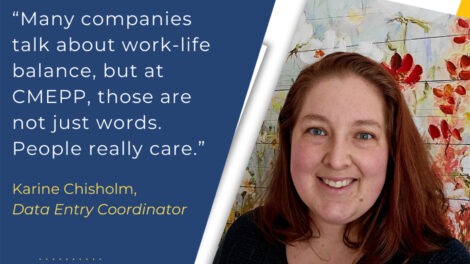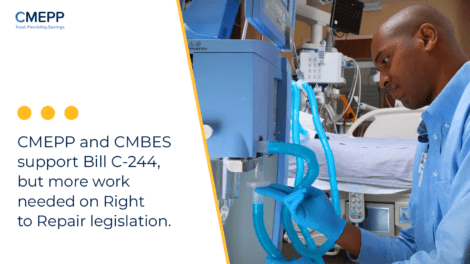The Right to Repair movement got a boost last year with the introduction of Bill C-244 (An Act to Amend the Copyright Act (diagnosis, maintenance and repair) by MP Wilson Miao. CMEPP applauded its arrival as a mechanism for ensuring our hospital Participant members can access an open and competitive marketplace for medical equipment service. The bill is a good starting point, but as we’ve grown to understand its nuances and limitations, we know it’s just the beginning of enshrining the Right to Repair.
Along the way, we’ve benefitted from the insights and productive partnerships with CMBES and longtime Right to Repair advocate and associate professor of Law and Computer Science at Dalhousie University, Dr. Anthony Rosborough.
When medical equipment can’t be fixed quickly and easily, the negative effects ripple throughout the hospital. Already overworked staff must look for options and patients face frustrating and dangerous delays.
But fixing equipment is no simple matter. Complex computer systems, intellectual property protections, and restricted access to tools and parts by manufacturers have put a wrench in the repair process.
Which explains the growing influence of the Right to Repair movement. CMEPP counts itself as one of several organizations and concerned individuals who have been pushing for legislative reforms.
Why we welcomed Bill C-244: In early 2023, there was light on the Right to Repair horizon. CMEPP and the Canadian Medical and Biological Engineering Society (CMBES) – along with some of our Suppliers, notably Christie Innomed – welcomed the introduction of Bill C-244 last year, a private members’ bill tabled by MP Wilson Miao.
The bill seeks to amend the existing Copyright Act to remove certain barriers the Act imposes on an owner’s ability to choose their preferred method for repair and maintenance of their equipment.
In this time of severe cost and resource constraints, removing the barriers to effective repair and maintenance of healthcare equipment was a watershed moment.
As it made its way through the House of Commons, there was an amendment to the bill which created a “carve out” for devices with embedded sound recordings. That may sound harmless to anyone in the medical device world, but as Dr. Rosborough helped us understand, the amendment does give manufacturers another tool to potentially prevent access to repair.
Getting tripped up by the language: There is still a lot to feel optimistic about, but after the amendment, interpreting the language and intent of the bill has become tricky. If anything, according to Rosborough, it creates more uncertainty with gray areas that are open to interpretation. As it looks now, it’s far from certain that this bill creates the Right to Repair legislation we’re looking for.
Where we’re at now: The bill with the amendment is now before the Senate. Last June CMEPP wrote to the Standing Committee seeking feedback on the bill, expressing our support for the bill – and has done so again, in a letter from CMBES and ourselves to the Senate Standing Committee on Social Affairs, Science and Technology.
Still a lot of work to do: We’re invigorated by this legislative change which overcomes some of the major hurdles to the Right to Repair. It’s the starting point we’ve been waiting for – giving hospital members the flexibility to manage the diagnosis, repair and maintenance of their equipment through recognized quality standards of service.
But we know this isn’t the end of the road. More legislative change needs to happen.
In our letter, we point out that our support of the bill comes with “the strong recommendation that future legislation and government involvement must resolve the issues of limited access to circumvention tools enabled by Bill C-244 and provide more clarity regarding the sharing of circumvention tools.”
In closing, we inform the Senators that CMEPP and CMBES would welcome the opportunity to support future work in this area to prioritize the health and safety of Canadians. We’re heavily invested in this process and want to continue to mobilize for comprehensive Right to Repair legislation.





